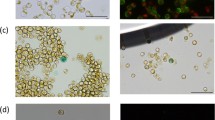Abstract
Synechococcus sp. CC9311 is a marine cyanobacterium characterized by type IV chromatic acclimation (CA). A genetic transformation system was developed as a first step to elucidate the molecular mechanism of CA. The results show that Synechococcus sp. CC9311 cells were sensitive to four commonly used antibiotics: ampicillin, kanamycin, spectinomycin, and chloramphenicol. An integrative plasmid to disrupt the putative phycoerythrin lyase gene mpeV, using a kanamycin resistance gene as selectable marker, was constructed by recombinant polymerase chain reaction. The plasmid was then transformed into Synechococcus sp. CC9311 via electroporation. High transformation efficiency was achieved at a field strength of 2 kV/cm. DNA analysis showed that mpeV was fully disrupted following challenge of the transformants with a high concentration of kanamycin. In addition, the transformants that displayed poor growth on agar SN medium could be successfully plated on agarose SN medium.
Similar content being viewed by others
References
Brahamsha B. 1996. A genetic manipulation system for oceanic cyanobacteria of the genus Synechococcus. Applied Environmental Microbiology, 62: 1 747–1 751.
Chiang G G, Schaefer M R, Grossman A R. 1992. Transformation of the filamentous cyanobacterium Fremyella diplosiphon by conjugation or electroporation. Plant Physiology Biochemistry, 30: 315–325.
Dufresne A, Ostrowski M, Scanlan D J, Garczarek L, Mazard S, Palenik B P, Paulsen I T, de Marsac N T, Wincker P, Dossat C, Ferriera S, Johnson J, Post A F, Hess W R, Partensky F. 2008. Unraveling the genomic mosaic of a ubiquitous genus of marine cyanobacteria. Genome Biology, 9(5): R90.
Everroad C, Six C, Partensky F. 2006. Biochemical bases of type IV chromatic adaptation in marine Synechococcus spp. Journal of Bacteriology, 188: 3 345–3 356.
Horton R M, Hunt H D, Ho S N, Pullen J K, Pease L R. 1989. Engineering hybrid genes without the use of restriction enzymes: gene splicing by overlap extension. Gene, 77: 61–68.
Jardillier L, Zubkov M V, Pearman J, Scanlan D J. 2010. Significant CO 2 fixation by small prymnesiophytes in the subtropical and tropical northeast Atlantic Ocean. ISME Journal, 4(9): 1 180–1 192.
Koksharova O A, Wolk C P. 2002. Genetic tools for cyanobacteria. Applied Microbiology Biotechnology, 58: 123–137.
Li W K W. 1994. Primary production of Prochlorophytes, Cyanobacteria, and Eucaryotic ultraphytoplankton: measurements from flow cytometric sorting. Limnology and Oceanography, 39(1): 169–175.
Matsunaga T, Takeyama H, Nakamura N. 1990. Characterization of cryptic plasmids from marine cyanobacteria and construction of a hybrid plasmid potentially capable of transformation of marine cyanobacterium, Synechococcus sp. and its transformation. Applied Biochemistry Biotechnology, 24/25: 151–160.
Matsunaga T, Takeyama H. 1995. Genetic engineering in marine cyanobacteria. Journal of Applied Phycology, 7: 77–84.
Mühlenhoff U, Chauvat F. 1996. Gene transfer and manipulation in the thermophilic cyanobacterium Synechococcus elongatus. Molecular and General Genetics, 252: 93–100.
Okamoto S, Ohmori M. 2002. The cyanobacterial PilT protein responsible for cell motility and transformation hydrolyzes ATP. Plant Cell Physiology, 43: 1 127–1 136.
Palenik B, Ren Q H, Dupont C L. 2006. Genome sequence of Synechococcus CC9311: insights into adaptation to a coastal environment. Proc. Natl. Acad. Sci. USA, 103(36): 13 555–13 559.
Palenik B. 2001. Chromatic adaptation in marine Synechococcus strains. Applied Environmental Microbiology, 67: 991–994.
Shen G Z, Bryant D A. 1995. Characterization of a Synechococcus sp. strain PCC 7002 mutant lacking Photosystem I. Protein assembly and energy distribution in the absence of the Photosystem I reaction center core complex. Photosynthesis Research, 44: 41–53.
Six C, Thomas J C, Garczarek L. 2007. Diveristy and evolution of phycobilisomes in marine Synechococcus spp.: a comparative genomics study. Genome Biology, 8: R259.
Toledo G, Palenik B. 1997. Synechococcus diversity in the California current as seen by RNA polymerase (rpoC 1) gene sequences of isolated strains. Applied Environmental Microbiology, 63(11): 4 298–4 303.
Waterbury J B, Watson S W, Valois F W. 1986. Biological and ecological characterization of the marine unicellular cyanobacterium Synechococcus. Canadian Bulletin of Fisheries and Aquatic Sciences, 214: 71–120.
Waterbury J B, Willey J M. 1988. Isolation and growth of marine planktonic cyanobacteria. Methods Enzymology, 167: 100–105.
Yoshihara S, Geng X X, Okamoto S. 2001. Mutational analysis of genes involved in pilus structure, motility and transformation competency in the unicellular motile cyanobacterium Synechocystis sp. PCC 6803. Plant Cell Physiol., 42: 63–73.
Zubkov M V, Sleigh M A, Tarran G A. 1998. Picoplanktonic community structure on an Atlantic transect from 50 degrees N to 50 degrees S. Deep-Sea Research I, 45: 1 339–1 355.
Author information
Authors and Affiliations
Corresponding author
Additional information
Supported by the Key Innovation Project of Institute of Oceanology, Chinese Academy of Sciences (No. 2009-2), the Natural Science Foundation of Shandong Province (No. 2009ZRB02542), the Foundation of Key Laboratory of Marine Bioactive Substance and Modern Analytical Techniques, SOA (No. MBSMAT-2010-03), the National Natural Science Foundation of China (No. 41276164), and the Natural Science Foundation of Jiangsu Province (No. BK2012650)
Rights and permissions
About this article
Cite this article
Chen, H., Lin, H., Jiang, P. et al. Genetic transformation of marine cyanobacterium Synechococcus sp. CC9311 (Cyanophyceae) by electroporation. Chin. J. Ocean. Limnol. 31, 416–420 (2013). https://doi.org/10.1007/s00343-013-2164-5
Received:
Accepted:
Published:
Issue Date:
DOI: https://doi.org/10.1007/s00343-013-2164-5




